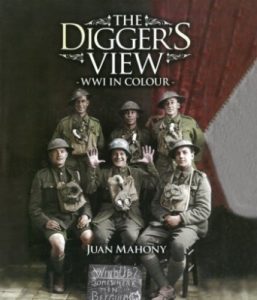- Author
- Book reviewer
- Subjects
- History - WW1, Book reviews, WWI operations
- Tags
-
- RAN Ships
- None noted.
- Publication
- June 2015 edition of the Naval Historical Review (all rights reserved)
 The Digger’s View – WWI in Colour by Juan Mahony. Published by The Digger’s View Pty Ltd, Newcastle, NSW, 2014. Hardback quarto size, 270 pages of high quality printing and artwork with numerous coloured photographs. rrp $50 – available from leading booksellers and www.thediggersview.com.au.
The Digger’s View – WWI in Colour by Juan Mahony. Published by The Digger’s View Pty Ltd, Newcastle, NSW, 2014. Hardback quarto size, 270 pages of high quality printing and artwork with numerous coloured photographs. rrp $50 – available from leading booksellers and www.thediggersview.com.au.
The author has provided a skilfully composed narrative taken from extracts of letters and diaries of Australian men who served in the Great War and these have been enhanced by numerous photographs. We have all seen grainy black and white photos from these times many with features barely discernible. Here the skill of Mahony and his colleagues is brought to the fore as photographs are enhanced and carefully coloured which adds another dimension and brings them to life as never seen before. Nowhere are the colours too bright but they are subtle which seems to complements the aura of the work and the dedication of time and place.
The volume takes us from the start of the conflict, through enlistment and on to the great battlefields of the Middle East and Europe. While this is essentially a Digger’s tale, a chapter is devoted to the Australia Flying Corps, possibly the only fault we find from a naval standpoint is, other than the Sydney – Emden engagement and the landings at Gallipoli, the RAN’s contribution is somewhat overlooked.
Through the photographic record we gain a sense of modern warfare for which we were ill prepared. Men trained by those who had fought in past short-term conflicts where light cavalry were formidable weapons were sent ashore to hostile beaches at Gallipoli. They mainly landed using improvised ship’s lifeboats, and then with rifles and a few rounds of ammunition, confronted entrenched patriots with covering machine guns under the overall direction of experienced Prussians. Those who later fought against the same enemy in Mesopotamia where they could use their cavalry skills were justly rewarded.
Images of Digger’s tell of those who went to the Western Front having the same encounters with trench warfare and even more machine guns plus artillery and gas attacks. Here however the terrain and weather were against boys used to brown dirt and sunshine, and their letters home explain how they had to contend with not only bullets and shells but cold and rain and that ever present mud.
The book is well researched considering such detail as the variety of dyes used by numerous clothing companies in preparing woollen uniforms, resulting in a spectrum of colours somewhere between green and brown. The quality of the images and their captions is reflected in their use by some national dailies. The Diggers’s View provides an interesting look into our history through some first class images not previously seen in this detail. It is a worthwhile accompaniment to any collection of WWI history.




